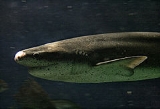
Broadnose sevengill shark
Encyclopedia
The broadnose sevengill shark (Notorynchus cepedianus) is the only extant member of the genus
Notorynchus, in the family Hexanchidae. It is recognizable because of its seven gill slits, while most shark
species
have five gill slits, with the exception of the members of the order Hexanchiformes
and the sixgill sawshark
.
The shark is gray or brownish with spots. It has one dorsal fin set far back along the spine towards the tail. Its top jaw has jagged cusped teeth and the bottom comb shaped. This adaptation allows the shark to eat sharks, rays, fish
, seal
s, and carrion
. The sharks live in temperate
areas worldwide, from the North Atlantic and Mediterranean, and from the shallows down to 135 m (450 ft) deep. Five unprovoked attacks on humans have been recorded since the 16th century. This shark is ovoviviparous, bearing live young. It grows up to 300 cm (10 feet) long.
Genus
In biology, a genus is a low-level taxonomic rank used in the biological classification of living and fossil organisms, which is an example of definition by genus and differentia...
Notorynchus, in the family Hexanchidae. It is recognizable because of its seven gill slits, while most shark
Shark
Sharks are a type of fish with a full cartilaginous skeleton and a highly streamlined body. The earliest known sharks date from more than 420 million years ago....
species
Species
In biology, a species is one of the basic units of biological classification and a taxonomic rank. A species is often defined as a group of organisms capable of interbreeding and producing fertile offspring. While in many cases this definition is adequate, more precise or differing measures are...
have five gill slits, with the exception of the members of the order Hexanchiformes
Hexanchiformes
Hexanchiformes is the order consisting of the most primitive types of sharks, and numbering just five extant species. Fossil sharks that were apparently very similar to modern sevengill species are known from Jurassic specimens....
and the sixgill sawshark
Sixgill sawshark
The sixgill sawshark, Pliotrema warreni, the only member of the genus Pliotrema, is a sawshark of the family Pristiophoridae, found in the subtropical waters of the western Indian Ocean between latitudes 23° S and 37° S, at depths of between 60 and 430 m. Its length is up to about...
.
The shark is gray or brownish with spots. It has one dorsal fin set far back along the spine towards the tail. Its top jaw has jagged cusped teeth and the bottom comb shaped. This adaptation allows the shark to eat sharks, rays, fish
Fish
Fish are a paraphyletic group of organisms that consist of all gill-bearing aquatic vertebrate animals that lack limbs with digits. Included in this definition are the living hagfish, lampreys, and cartilaginous and bony fish, as well as various extinct related groups...
, seal
Pinniped
Pinnipeds or fin-footed mammals are a widely distributed and diverse group of semiaquatic marine mammals comprising the families Odobenidae , Otariidae , and Phocidae .-Overview: Pinnipeds are typically sleek-bodied and barrel-shaped...
s, and carrion
Carrion
Carrion refers to the carcass of a dead animal. Carrion is an important food source for large carnivores and omnivores in most ecosystems. Examples of carrion-eaters include vultures, hawks, eagles, hyenas, Virginia Opossum, Tasmanian Devils, coyotes, Komodo dragons, and burying beetles...
. The sharks live in temperate
Temperate
In geography, temperate or tepid latitudes of the globe lie between the tropics and the polar circles. The changes in these regions between summer and winter are generally relatively moderate, rather than extreme hot or cold...
areas worldwide, from the North Atlantic and Mediterranean, and from the shallows down to 135 m (450 ft) deep. Five unprovoked attacks on humans have been recorded since the 16th century. This shark is ovoviviparous, bearing live young. It grows up to 300 cm (10 feet) long.

